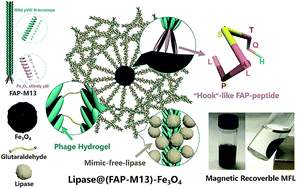Virus-templated magnetic composite hydrogels for surface immobilization of mimic-free-lipase†
Abstract
Surface immobilization of enzymes on magnetic-recoverable carriers is of great interest and importance for the biocatalysis of relatively large molecules. In this work, the nanosized amino-rich filamentous M13 virus, a versatile biological scaffold, was applied as the unique soft backbone for lipase immobilization. Based on the structure and capsid proteins of M13 phages, the magnetic-recoverable mimic-free-lipases (MFLs) composed of the M13 hydrogels and magnetic particles were developed in two designs. In the first design, nanosized wild M13 phages were crosslinked into a phage hydrogel through the N-terminals of pVIII peptides while NH2-Fe3O4 magnetic nanoparticles (MNPs) were attached to the M13 virus through glutaraldehyde, forming the M13-(NH2-Fe3O4) magnetic phage hydrogel. In the second design, special M13 with Fe3O4 affinity pIII-peptide (FAP-M13) was biopanned for strongly binding towards bare Fe3O4 with the “hook”-like pIII-peptide (N-LPLSTQH-C). TEM observation confirmed the direct grasp of FAP-M13 on bare Fe3O4, forming the magnetic (FAP-M13)-Fe3O4 virus hydrogel. Lipases were uniformly anchored on the phage surface of nanoscale by crosslinking with the N-terminals of pVIII peptides, and then lipase@M13-(NH2-Fe3O4) and lipase@(FAP-M13)-Fe3O4 MFLs were constructed. For both MFLs, high activity recovery yield (>95%) and efficient magnetic separation were characterized. Significantly reduced MNP-usage-amount and enhanced lipase-loading-amount both by about 40 folds were obtained, compared with the conventional NH2-Fe3O4 carriers. The quantified Km and Vmax/Km values were almost equal to those of the free lipases, verifying free-enzyme-mimicking features of the MFLs. High pH-tolerance, wide temperature adaptability, enhanced thermal stability and stable magnetic separation capability of both MFLs were also observed. In particular, the (FAP-M13)-Fe3O4 magnetic virus hydrogel simply using bare Fe3O4 MNPs would be more convenient and economical in the scaled-up biocatalysis.



 Please wait while we load your content...
Please wait while we load your content...